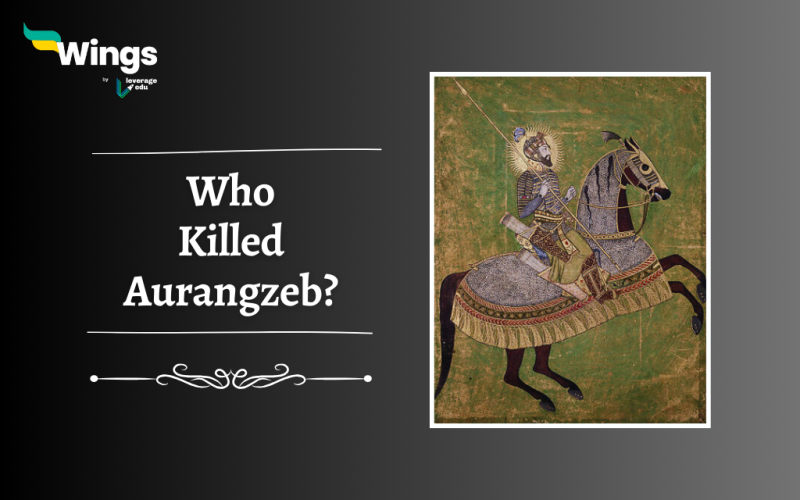In the year 1707, the Mughal Emperor Aurangzeb, also known as Alamgir, took his last breath in Ahmednagar. Aurangzeb’s death sparked speculation and theories about who might have been responsible for the demise of one of the most powerful rulers in Indian history. The sixth Mughal emperor is known for his rigid policies, religious intolerance and ruthless tactics. Let’s delve into the various perspectives and uncover the truth behind the question, “Who killed Aurangzeb?”
Table of Contents [show]
Theories Surrounding Aurangzeb’s Death
Mughal Emperor Aurangzeb is believed to have died on the morning of 20th February 1707 and is buried at Khuladabad, a sculpture which was built by himself. Some of the theories about his death are –

Theory 1: Natural Causes
One of the most prevalent theories suggests that Aurangzeb died of natural causes. At the age of 88, after a long and tumultuous reign, it is possible that the emperor succumbed to old age and related illnesses. Chronic illnesses such as asthma, diabetes, and kidney failure have been cited as possible causes of his demise.
Also Read – Who Defeated Jahangir?
Theory 2: Sons’ Conspiracy
Another theory suggests that Aurangzeb’s sons, particularly Azam Shah and Muhammad Kam Bakhsh, might have conspired to eliminate their father in a bid to claim the throne. The succession struggle within the Mughal royal family was a common theme throughout the empire’s history, and Aurangzeb’s harsh treatment of his sons during his reign only fueled their desire for power. Some accounts hint at a poisoning plot orchestrated by the ambitious princes to secure their positions as the next Mughal Emperor.
Also Read – How did Jahangir Die?
Theory 3: Political Enemies
Aurangzeb’s long and controversial reign was marked by constant warfare, economic challenges and religious conflicts. As a result, he had garnered many enemies, both within and outside the empire. Some historians speculate that Aurangzeb’s death might have been orchestrated by his political rivals, including the Marathas, Rajputs, and various regional powers that had clashed with the Mughal Empire during his rule.
In conclusion, while some accounts attribute his death to natural causes, others point to familial intrigues or political conspiracies. The truth behind Aurangzeb’s demise may never be fully known. The mystery of who killed Aurangzeb remains a topic of debate among historians and scholars. While there are various theories and speculations surrounding his death, conclusive evidence is lacking.
How Did Shivaji Defeat Aurangzeb?
Shivaji did not directly defeat the Mughal emperor. However, he was able to resist the Mughal expansion through surprise attacks, guerrilla warfare, and strategic fort captures. He escaped from Agra in 1666 and continued to resist the Mughals. This eventually weakened the Mughal control in the Deccan. After the death of Shivaji, his successors continued to fight. Later, the Marathas fought against the Mughals. This eventually led to to decline of the power of the Mughals.
Who is Stronger, Aurangzeb or Shivaji?
The answer depends on what you consider a strength. Aurangzeb had strength in terms of his vast empire. On the other hand, Shivaji was good at military tactics and leadership. Therefore, he was able to fight against the Mughals. The table below shows the comparison of the strengths in different areas.
| Aspect | Aurangzeb | Shivaji |
| Empire Size | Ruled one of the largest empires in Indian history. | Controlled a smaller but strategically strong Maratha kingdom. |
| Military Strategy | Relied on large armies and prolonged sieges. | Used guerrilla warfare, swift raids, and fort-based defenses. |
| Governance | Centralized rule, but faced frequent rebellions. | Decentralized administration with local governance. |
| Religious Policy | Imposed strict Islamic laws, leading to unrest. | Promoted religious tolerance and Hindu-Muslim unity. |
| Legacy | Expanded the Mughal Empire but led to its decline. | Laid the foundation for the powerful Maratha Empire. |
Where is Aurangzeb Buried?
As per his wish, after his death, his body was taken to Khuldabad, Maharashtra. He is buried beside his son Azam Shah and daughter Zinat-un-Nissa. His tomb is near the Sufi saint Sheikh Zainuddin. Unlike other Mughal emperors, Aurangzeb’s tomb is simple and unadorned. This reflects the kind of lifestyle he led. The tomb is simple because of his wish.
FAQs
Guru Tegh Bahadur was a sikh guru who was put to death by Aurangzeb. Aurangzeb executed him because he did not convert to Islam and opposed forced conversions. Gurudwara Sis Ganj Sahib and Gurdwara Rakab Ganj Sahib are mark the places of cremation of the guru.
Humayun was considered the weakest Mughal King. He is considered the weakest because he was inexperienced. Under his role, the majority of the territories were lost to the rising Sur Empire.
The biggest enemy of Aurangzeb was the Marathas mainly under the leadership of Shivaji and later Sambhaji. His enemies used unconventional guerrilla warfare tactics and military strategies to resist the Mughal Empire.
Relevant Blogs
| Muhammad Ghori | Mahmud Ghazni |
| Megasthenes | Who was Ibn Battuta |
| Prithviraj Chauhan | How Akbar Died? |
| Maharana Pratap | Babur |
| Ashoka | Humayun |
This was all about who killed Aurangzeb. If you want to know more about topics like this, then visit our general knowledge page! Alternatively, you can also read our blog on general knowledge for competitive exams!
 One app for all your study abroad needs
One app for all your study abroad needs















 45,000+ students trusted us with their dreams. Take the first step today!
45,000+ students trusted us with their dreams. Take the first step today!
